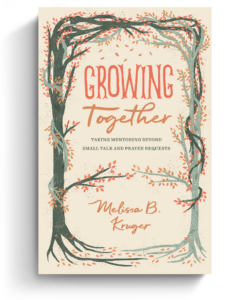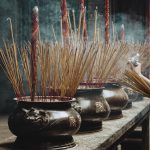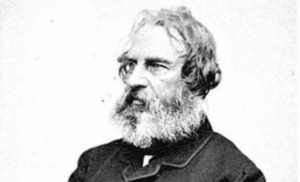Editors’ note: Would you join us in helping thousands of church leaders in China by providing gospel-centered resources? Between now and April 1, all gifts to our Chinese Outreach will be matched (up to $40,000). Click here to learn more about this Theological Famine Relief project.
Previously:
- Send Gospel Resources to China (Bill Walsh)
- Chinese Christians Preparing for ‘New Normal’ (Andrew Kaiser)
- What Christianity in China Is Really Like (Colin Clark)
- The Church in China at the Threshold (Brent Fulton)
The man crawled along the dusty cement beam near where the giant bell was hanging in the steeple, shining his flashlight on it.
He read aloud the letters engraved on the side, one by one: “B. U. C. K. E. Y. E.”
My friend Noël and I looked at each other in bewilderment. “Buckeye?”
He continued reading what was written on the old bell: “Buckeye Bell Foundry, Cincinnati. First Baptist Church Coffeyville, Kansas. Presented by W. S. Upham, 1886. Praise Ye the Lord.”
We were stunned. Here we were, staring at a bell cast in Ohio for a church in Kansas, hanging in a steeple in western China.
My mind swirled as I thought about the turmoil the bell had witnessed during its century in China: the Revolution in 1911 that toppled the Qing dynasty and brought an end to 2,000 years of dynastic rule; the Warlord Era, when China effectively broke up into regional fiefdoms run by local warlords; the Japanese invasion and occupation; the Civil War between the Nationalists and Communists; “Liberation,” when the Communist Party proclaimed the establishment of the “People’s Republic of China” and began the fundamental transformation of an ancient nation; and the slow turn from Chairman Mao’s China into the China of today.
Story of Silence
Our research trip into the life of missionary Esther Nelson (1810–1843) had brought us to Yibin, a remote city of 5 million people in Sichuan, most famous in China for its potent rice wine. We were being shepherded around by our intrepid guide and friend.
Before our arrival, our guide had contacted the pastor to arrange a visit. On a late Thursday afternoon, after a drive across the mountains of central Sichuan, we met the pastor in his office to learn what we could about the history of his church.
The Lu Jiao Yuan Christian Church was founded in 1896 by missionaries from the American Baptist Foreign Mission Society (ABFMS), and served as the base of operations for their work in Yibin (then called Xufu) and southern Sichuan. After the missionaries were expelled in the 1950s, the church came under the supervision of the Three Self Patriotic Committee Movement (TSPM). It remained open until the 1960s when Chairman Mao, fearing that he was losing his grip on power within the Chinese Communist Party, launched his most daring and brutal political campaign.
During this time Christianity came under more direct assault. As everything in Chinese life became political, Christianity was increasingly viewed as a foreign religion and Christians as enemies and potential traitors. Anything considered foreign was abolished or destroyed. During this time the party decided it wanted to rid society of religion altogether, forcing the closure of all religious venues. Temples, mosques, and churches were taken over by local party governments and turned into schools, factories, and warehouses.
The bells were silent.
Silence Shattered
The death of Chairman Mao in 1976 brought an end to the revolution. Mao’s successor, Deng Xiaoping (1904–1997) launched a campaign to modernize the country and open it to the outside world. Eventually China re-engaged diplomatically on the world stage, and internally the party began a gradual turn away from dogmatic Marxism. It instituted free-market economic reforms and loosened its grip on the lives of Chinese citizens.
This easing included the relaxation of its anti-religious policies. The ban on religious activities was lifted. Across the country church buildings were returned to their congregations, and pastors were released from prison. As pastors and parishioners returned to their buildings, they found that many of the church artifacts had been removed or destroyed—pews, pulpits, stained glass windows, and bells. The arduous process of restoring their places of worship began.
More churches reopened as religious policies continued to relax. By the late 1990s some of the lost bells had made their way home, each with a story to tell. Many of them would no longer be silent.
Too Strong to Silence
After a couple of hours of drinking tea and poring over old documents, piecing together the story of the church and finding points of connection to our research, the pastor asked Noël and me if we could help him with something.
“There’s an old bell in our steeple,” he said. “It has English writing on it, but we can’t read it. Perhaps you can translate it for us.” Of course, we were eager to see this bell with English writing on it.
The sun was setting as we made our way to the steeple. As we entered, we immediately spotted the bell hanging from the ceiling; unfortunately, it was too high for us to get a good look at it. There was a cement beam stretching across the inside of the steeple just beside the bell, so we reasoned that if we could get on that beam we could get a good look at the bell and read the inscription.
The pastor fetched a ladder but refused to let Noël or me climb up there. He was happy that we were there, but there no way was he going to risk having two injured foreign women on his hands! Our guide, who’s younger and more athletic, grabbed his flashlight and scampered up to get a good look at the inscription.
 The pastor told us that the bell had hung in the church until the revolution in the 1960s, when the local authorities closed the church and demolished the bell tower. The bell was taken to a local factory.
The pastor told us that the bell had hung in the church until the revolution in the 1960s, when the local authorities closed the church and demolished the bell tower. The bell was taken to a local factory.
The church remained closed until the mid-1980s. Shortly afterwards, the pastor at the time received word that their old bell was in a nearby factory. He asked the local government office to help them secure the return of their bell. In 1993 the factory agreed to return the bell for a fee.
When the new church building was constructed in 2000 they made sure it had a steeple to house the bell, which is now rung every Sunday morning to mark the beginning of worship.
After descending the stairs from the steeple, we paused on the rooftop for a while to watch as nightfall enveloped the bustling city. I was, of course, still thinking about the bell. How had it endured?
After we were back in the sanctuary I asked the pastor: “How did this bell survive the political campaigns?”
“They tried to destroy it,” he said, “but they couldn’t; it was too strong.”
Just like the church in China, I thought. They tried to destroy it, but it was too strong. At that moment the bell became a symbol for me of God’s faithfulness to his people in China.
Editors’ note: You can read this and other stories in Joann Pittman’s new book, The Bells Are Not Silent: Stories of Church Bells in China.
Involved in Women’s Ministry? Add This to Your Discipleship Tool Kit.
 We need one another. Yet we don’t always know how to develop deep relationships to help us grow in the Christian life. Younger believers benefit from the guidance and wisdom of more mature saints as their faith deepens. But too often, potential mentors lack clarity and training on how to engage in discipling those they can influence.
We need one another. Yet we don’t always know how to develop deep relationships to help us grow in the Christian life. Younger believers benefit from the guidance and wisdom of more mature saints as their faith deepens. But too often, potential mentors lack clarity and training on how to engage in discipling those they can influence.
Whether you’re longing to find a spiritual mentor or hoping to serve as a guide for someone else, we have a FREE resource to encourage and equip you. In Growing Together: Taking Mentoring Beyond Small Talk and Prayer Requests, Melissa Kruger, TGC’s vice president of discipleship programming, offers encouraging lessons to guide conversations that promote spiritual growth in both the mentee and mentor.

































